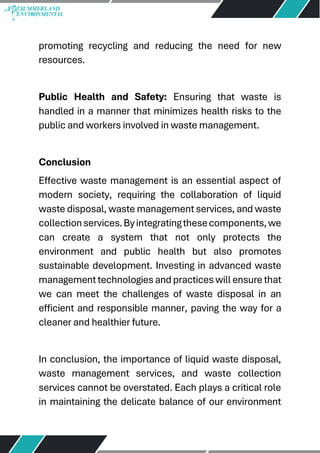An Unbiased View of Reclaim Waste
An Unbiased View of Reclaim Waste
Blog Article
The smart Trick of Reclaim Waste That Nobody is Talking About
Table of ContentsThe 9-Minute Rule for Reclaim WasteSome Known Details About Reclaim Waste The Buzz on Reclaim WasteExcitement About Reclaim WasteAbout Reclaim Waste
Check out the types, occurrences, and forms of liquid waste. Domestic sewage waste refers to the waste and products from a residential septic system. This type of waste is created by humans in homes, schools, and various other buildings. This only consists of septic systems that have a drain area. The correct management and disposal of residential sewage waste call for fluid waste to be transferred to a sewer therapy plant where the correct techniques and tools are put on cleanse and deal with waste.
Business waste frequently consists of potential dangers, such as flammable products or a blend of fluid and solid waste items, and needs an advanced and thorough disposal process. The disposal of industrial waste typically involves the purification of waste prior to transport to make certain risk-free and appropriate disposal. Hazardous waste is developed from by-products and runoff of industrial procedures and production.
This type of waste can not utilize the same sewage monitoring transport or procedures as septic or industrial liquids. The industrial waste management procedure calls for the evaluation and screening of liquid waste before it undertakes the disposal procedure (industrial wastewater treatment). Drainage waste is the liquid waste that comes from drainage and excess stormwater in very populated locations or cities
Runoff waste can create contamination and flooding if not taken care of effectively. Ensuring appropriate waste monitoring can protect against disasters and minimize environmental harm.
What Does Reclaim Waste Do?
Contact PROS Solutions today to learn more about our waste administration and disposal services and the appropriate ways to care for the liquid waste you produce.
(https://allmyfaves.com/reclaimwaste1?tab=Reclaim%20Waste)This supposed 'wastewater' is not only an important source however, after therapy, will be released to our land, waterways or the sea. Used water from toilets, showers, bathrooms, kitchen sinks, washings and commercial processes is recognized as wastewater.

water used to cool down equipment or tidy plant and devices). Stormwater, a kind of wastewater, is overflow that streams from agricultural and urban areas such as roofings, parks, gardens, roadways, paths and rain gutters into stormwater drains, after rainfall. Stormwater streams without treatment straight to regional creeks or rivers, ultimately reaching the ocean.
Facts About Reclaim Waste Uncovered
In Queensland, the majority of wastewater is treated at sewer treatment plants. Wastewater is transported from residential or industrial websites through a system of drains and pump terminals, recognized as sewage reticulation, to a sewage treatment plant.
The Division of Natural Resources advises city governments concerning managing, operating and maintaining sewage systems and treatment plants. In unsewered areas, regional governments might require homeowners to set up specific or family sewer treatment systems to treat domestic wastewater from commodes, cooking areas, shower rooms and washings. The Division of Natural Resources authorises the usage of family systems when they are confirmed to be effective.
Most stormwater gets no treatment. In some brand-new neighborhoods, treatment of some stormwater to get rid of litter, sand and gravel has begun utilizing gross contaminant traps. Wastewater therapy takes place in four phases: Eliminates strong issue. Larger solids, such as plastics and various other things mistakenly released to drains, are eliminated when wastewater is passed via screens.
Wastewater after that moves into large containers where solids settle and are removed as sludge. Oil and scum are skimmed from the surface. Makes use of small visit their website living organisms recognizes as micro-organisms to break down and eliminate staying liquified wastes and great particles. Micro-organisms and wastes are integrated in the sludge. Gets rid of nitrogen and phosphorus nutrients that might create algal blooms in our waterways and threaten water life.
The Definitive Guide to Reclaim Waste
Nutrient elimination is not available whatsoever sewage therapy plants due to the fact that it calls for costly specialized equipment. It is ending up being much more usual in Queensland. Clear fluid effluent generated after treatment may still include disease-causing micro-organisms. If this effluent is released into waterways such as rivers or the sea, the micro-organisms will eventually pass away out.

This generally suggests wastewater needs to be dealt with or impurities eliminated prior to it can be discharged to waterways. A lot of wastewater flows right into the sewage system. Under the Act, neighborhood federal governments carry out approvals and licences for environmentally relevant activities (Ages) involving wastewater releases that could have a neighborhood influence. The department provides authorizations and licences to Ages including wastewater releases that might have a regional or statewide effect.
Little Known Questions About Reclaim Waste.
Or else, samples are considered lab analysis. Often many tests are needed to develop the degrees of each of the various pollutants such as oils, heavy metals and chemicals in water. Tracking provides valid details regarding water top quality and can confirm that licence problems are being satisfied. The information acquired with monitoring offers the basis for making water top quality decisions.
Report this page